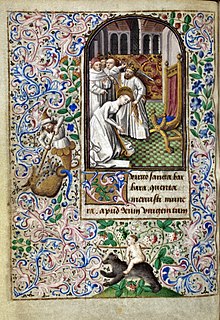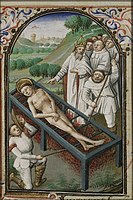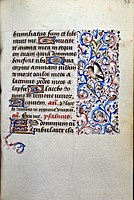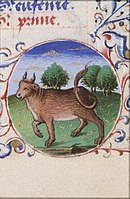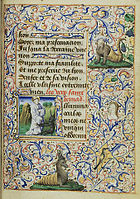
JeanFouquet was a French painter and miniaturist. A master of panel painting and manuscript illumination, and the apparent inventor of the portrait miniature, he is considered one of the most important painters from the period between the late Gothic and early Renaissance. He was the first French artist to travel to Italy and experience first-hand the early Italian Renaissance.

The Royal Library of the Netherlands is the national library of the Netherlands, based in The Hague, founded in 1798.

Simon Bening was a Flemish miniaturist, generally regarded as the last major artist of the Netherlandish tradition.

Simon Marmion was a French and Burgundian Early Netherlandish painter of panels and illuminated manuscripts. Marmion lived and worked in what is now France but for most of his lifetime was part of the Duchy of Burgundy in the Southern Netherlands.

The Getty Tondal, also known as Les visions du chevalier Tondal is an illuminated manuscript from 1475, now in the Getty Museum. It is a French version and is the only surviving fully illuminated manuscript of the Visio Tnugdali. It has 20 miniatures by Simon Marmion and elaborate borders with "CM" for the initials of Margaret of York, Duchess of Burgundy and her husband Charles the Bold. The text was scribed by David Aubert in Ghent, while the miniatures were done in Valenciennes, where Marmion was based. Only the fifteen pages with two-column miniatures and five pages with single column miniatures have borders. There are only 45 folios, meaning that most have miniatures. The manuscript is fully available online.
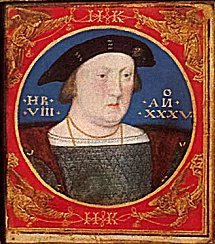
Lucas Horenbout, often called Hornebolte in England, was a Flemish artist who moved to England in the mid-1520s and worked there as "King's Painter" and court miniaturist to King Henry VIII from 1525 until his death. He was trained in the final phase of Netherlandish illuminated manuscript painting, in which his father Gerard was an important figure, and was the founding painter of the long and distinct English tradition of portrait miniature painting. He has been suggested as the Master of the Cast Shadow Workshop, who produced royal portraits on panel in the 1520s or 1530s.
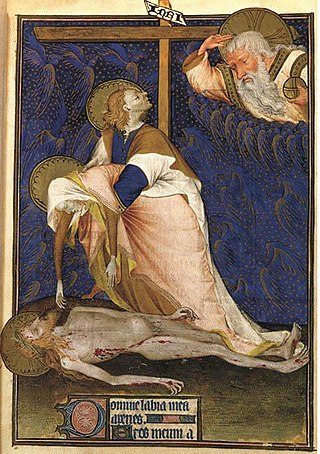
The Grandes Heures de Rohan is an illuminated manuscript book of hours, painted by the anonymous artist known as the Rohan Master, probably between 1418 and 1425, in the Gothic style. It contains the usual offices, prayers and litanies in Latin, along with supplemental texts, decorated with 11 full page, 54 half page, and 227 small miniatures, decorated with tempera paints and gold leaf. The book margins are decorated with Old Testament miniatures with captions in Old French, in the style of a Bible moralisée. The full page illuminations are renowned for the highly emotional and dramatic portrayal of the agonies of Christ and the grief of the Virgin. According to Millard Meiss, "The Rohan Master cared less about what people do than what they feel. Whereas his great predecessors excelled in the description of the novel aspects of the natural world, he explored the realm of human feeling." Meiss concludes that the Rohan Master was the "greatest expressionist in 15th century France." The manuscript is currently housed in the Bibliothèque Nationale, Paris, France.

The Turin–Milan Hours is a partially destroyed illuminated manuscript, which despite its name is not strictly a book of hours. It is of exceptional quality and importance, with a very complicated history both during and after its production. It contains several miniatures of about 1420 attributed to an artist known as "Hand G" who was probably either Jan van Eyck, his brother Hubert van Eyck, or an artist very closely associated with them. About a decade or so later Barthélemy d'Eyck may have worked on some miniatures. Of the several portions of the book, that kept in Turin was destroyed in a fire in 1904, though black-and-white photographs exist.

The Belles Heures of Jean de France, Duc de Berry, or Belles Heures of Jean de Berry is an early 15th-century illuminated manuscript book of hours commissioned by the French prince John, Duke of Berry, around 1409, and made for his use in private prayer and especially devotions to the Virgin Mary. The miniatures of the Belles Heures are mostly painted by the Limbourg brothers; very few books of hours are as richly decorated as it.

The Hours of Étienne Chevalier is an illuminated book of hours commissioned by Étienne Chevalier, treasurer to king Charles VII of France, from the miniature painter and illuminator Jean Fouquet.

The Hours of Mary of Burgundy is a book of hours, a form of devotional book for lay-people, completed in Flanders around 1477, and now in the National Library of Austria. It was probably commissioned for Mary, the ruler of the Burgundian Netherlands and then the wealthiest woman in Europe. No records survive as to its commission. The book contains 187 folios, each measuring 225 by 150 millimetres. It consists of the Roman Liturgy of the Hours, 24 calendar roundels, 20 full-page miniatures and 16 quarter-page format illustrations. Its production began c. 1470, and includes miniatures by several artists, of which the foremost was the unidentified but influential illuminator known as the Master of Mary of Burgundy, who provides the book with its most meticulously detailed illustrations and borders. Other miniatures, considered of an older tradition, were contributed by Simon Marmion, Willem Vrelant and Lieven van Lathem. The majority of the calligraphy is attributed to Nicolas Spierinc, with whom the Master collaborated on other works and who may also have provided a number of illustrations.

Jean Wauquelin presenting his 'Chroniques de Hainaut' to Philip the Good is a presentation miniature believed to have been painted by the Flemish artist Rogier van der Weyden. It decorates the frontispiece to the Chroniques de Hainaut, MS KBR.9242, Jean Wauquelin's French translation of a three-volume history of the County of Hainaut originally written in Latin by the 14th-century Franciscan historian Jacques de Guyse.

The Hours of Joanna I of Castile is a sixteenth-century illuminated codex housed in the British Library, London, under call number Add MS 35313.

The Ghent–Bruges school is a distinctive style of manuscript illumination which was prevalent in the Southern Netherlands from about 1475 to about 1550. Though the name highlights the importance of Ghent and Bruges as centres for manuscript production, manuscripts in the style were produced in a wider area.

The Munich-Montserrat Book of Hours is a 1535 illuminated manuscript book of hours. It measured 10 by 14 cm in its original form. It was produced by Simon Bening and his workshop, possibly for Alonso de Idiaquez, royal secretary to Charles V, Holy Roman Emperor. Its miniatures are stylistically similar to other books of hours by Bening and his workshop, such as the Da Costa Book of Hours, the Hennessy Book of Hours and the Hours of Isabella of Portugal, all produced for Spanish nobles.

The Spinola Hours is a illuminated manuscript book of hours of about 1510-1520, consisting of 312 folios, over 80 of which are mainly decorated with miniature paintings. It was produced between Bruges and Ghent in Flanders around 1510-1520, and is a key work of the Ghent–Bruges school of illuminators. According to Thomas Kren, a former curator of the J. Paul Getty Museum, the miniatures within the Spinola Hours can be attributed to five distinct sources. Forty-seven of these illuminated pages can be attributed to the 'Master of James IV'. Since 1883 it has been in the J. Paul Getty Museum in Malibu, catalogued as Ms. Ludwig IX 18 (83.ML.114).

The Hours of Louis XII was an illuminated manuscript book of hours produced by Jean Bourdichon for Louis XII of France. It was begun in 1498 or 1499, going by the king's age of 36 given below his portrait; he became king on 7 April 1498. The book reached England, where it was broken up around 1700. Now only parts of it survive – in total sixteen full-page miniature paintings, two sheets of text and fifty-one sheets of text bound in the wrong order as a thin volume.
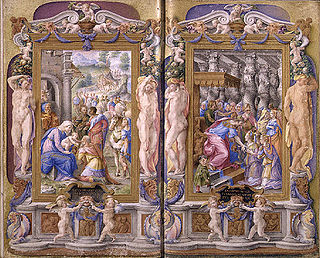
Renaissance illumination refers to the production of illuminated manuscripts in Western Europe in the late 15th and 16th centuries, influenced by the representational techniques and motifs of Renaissance painting. With the invention of printing, book painting did not disappear abruptly, but continued in certain luxury manuscripts, and even in some printed works. Illuminators of the period used techniques of perspective representation and iconographic themes specific to the period. Restricted to luxury works, this type of production declined in the second half of the 16th century, as engraving became increasingly competitive.

The Master of the Houghton Miniatures is the conventional name of an illuminator probably active in Ghent between 1476 and 1480. He owes his name to a book of hours that he illuminated, currently kept in the Houghton Library at Harvard University.
The Master of Cardinal de Bourbon was an anonymous master illuminator active in France between 1470 and 1500. His name was inspired by the manuscript evoking the life and miracles of Saint Louis, illuminated for the cardinal and archbishop of Lyon, Charles II de Bourbon. Little is known about his career, which is largely based on conjecture. Born in Flanders, he trained in the orbit of the Master of Margaret of York's group in the Bruges region. He may have passed through Rouen in the 1470s, before settling in Paris in the 1480s, where he illuminated a large number of manuscripts for relatives of King Louis XI. It has been suggested that he was identified with Guérard Louf, a painter and sculptor from Utrecht who settled in Rouen, but this identification has since been called into question.
